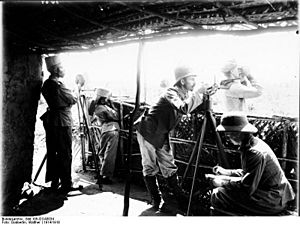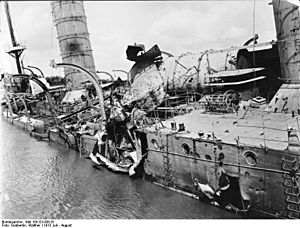Battle of Rufiji Delta facts for kids
Quick facts for kids Battle of the Rufiji Delta |
|||||||
|---|---|---|---|---|---|---|---|
| Part of the East African Campaign of the First World War | |||||||
 Wreck of Königsberg |
|||||||
|
|||||||
| Belligerents | |||||||
| Commanders and leaders | |||||||
| Strength | |||||||
| 1 light cruiser 1 supply ship 1 freighter (ex-British) |
1 pre-dreadnought 4 cruisers 2 monitors various smaller craft 1 blockship 1 civilian & 9 naval aircraft |
||||||
| Casualties and losses | |||||||
| 33 killed (mostly due to disease) 1 light cruiser sunk 1 supply ship sunk 1 freighter sunk |
6 aircraft destroyed (1 civilian & 5 naval, mostly through attrition) |
||||||
The Battle of the Rufiji Delta was a series of naval fights during World War I. It took place in German East Africa (which is now Tanzania) from October 1914 to July 1915. The battle was between a German warship, the light cruiser SMS Königsberg, and a strong group of British warships. The main goal for the British was to find and sink the German ship, which was hiding in the delta.
Contents
Why the Battle Started
In 1914, the Königsberg was the most powerful German ship in the Indian Ocean. After a battle where it sank the British ship HMS Pegasus, the Königsberg had engine problems. It needed repairs.
To stay safe, the Königsberg and its supply ship, Somali, hid deep inside the Rufiji River delta. The damaged engine parts were sent to Dar es Salaam for fixing.
Towards the end of October, a British cruiser, HMS Chatham, found the Königsberg in the delta. Soon after, two more British cruisers, HMS Dartmouth and Weymouth, arrived. They blocked the German ship from leaving the delta.
The British ships were much stronger than the Königsberg. However, they could not sail into the shallow delta waters. The German crew tried to hide their ship by making it look like the surrounding forest.
The British Blockade and Search
The British tried many ways to sink the Königsberg. They even tried to send a small torpedo boat into the delta, but the Germans easily stopped it.
To prevent the Königsberg from escaping, the British sank a ship called Newbridge across one of the delta's exits. This was a blockship. But they soon realized the German ship could still get out through other channels. The British then placed fake mines in some of these other paths.
The British also used airplanes to find the hidden German ship. A civilian pilot named Cutler used his Curtiss seaplane to look for it. His plane was shot down, but he confirmed the ship was still there. The Royal Naval Air Service sent two Sopwith seaplanes to scout and bomb the ship. But these planes quickly broke down in the hot, humid weather.
Three Short seaplanes did a bit better. They managed to take photos of the Königsberg. However, they also had problems with the heat and German gunfire.
The British tried to use the large guns of the old battleship HMS Goliath. But the water was too shallow for the battleship to get close enough to hit the Königsberg.
A skilled tracker and hunter named P. J. Pretorius helped the British Navy. He knew the delta well. He helped them find the Königsberg's exact location. He also helped figure out which waterways were deep enough for the British ships to use.
By March 1915, the Königsberg was running low on food. Many of its crew members were sick from tropical diseases. Their spirits were low because they were cut off from the outside world.
The Germans tried to resupply the ship. They used a captured British merchant ship, the Rubens. They renamed it Kronborg and gave it a Danish flag and fake papers. German sailors who could speak Danish pretended to be the crew. The ship was loaded with coal, guns, and supplies.
The Kronborg managed to get into East African waters. But the British ship HMS Hyacinth found it. The Hyacinth chased the Kronborg to Manza Bay. The German crew set their ship on fire to prevent it from being captured. Later, the Germans managed to save many of the supplies from the burnt ship. These supplies were used in the land battles and some were sent to the Königsberg.
The Sinking of Königsberg
In June 1915, two special British warships called monitors arrived. These were HMS Mersey and Severn. They were towed all the way from Malta. These monitors had a shallow design, perfect for the delta.
The monitors had extra armor added. They were also protected by a heavy bombardment from other British ships. They sailed into the delta. Four British airplanes (two Caudrons and two Henry Farmans) helped by spotting where the shells landed.
The monitors and the Königsberg fought a long-range battle. The Königsberg also had help from spotters on shore. On the first day, the Mersey was hit, and the monitors couldn't hit the Königsberg.
But they returned on July 11. This time, their powerful guns destroyed the Königsberg's weapons. The German ship was badly damaged. Around 2:00 PM, Commander Looff ordered his crew to sink the ship themselves with a torpedo. This is called scuttling. After the battle, the British Navy was clearly the strongest naval power in the Indian Ocean.
What Happened Next
The day after the battle, the 188 surviving German crew members buried 33 of their comrades. A plaque was placed near the graves. It said, "Killed in action during the sinking of SMS Königsberg on 11 July 1915..." followed by the names of the dead.
The Germans managed to save ten of the Königsberg's guns. They put these guns on makeshift carts. They used them as powerful field guns in their fight against the Allies on land. Some guns were used to protect the harbor in Dar es Salaam. One gun was even put on a passenger ship called Graf von Götzen. The last of these guns was not put out of action until October 1917. The remaining crew from the Königsberg became ground troops. They fought under General Paul Emil von Lettow-Vorbeck.
Three of the Königsberg's guns still exist today. One is on display outside Fort Jesus in Mombasa, Kenya. Another is outside the Union Building in Pretoria, South Africa. The third is at Jinja Barracks in Uganda.
In Books and Movies
- Shout at the Devil (a book from 1968)
- Shout at the Devil (a movie from 1976)




